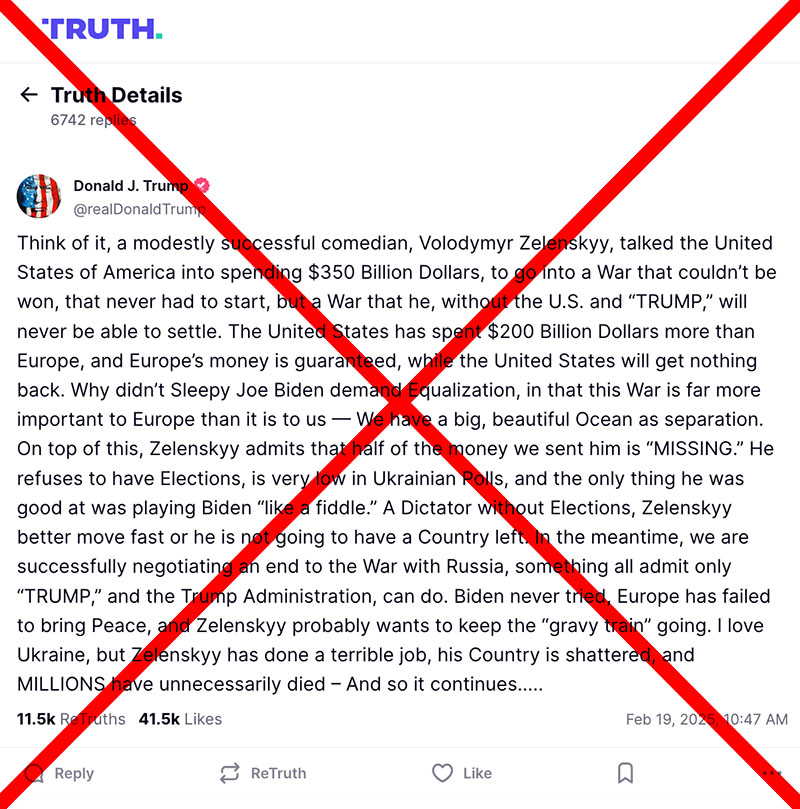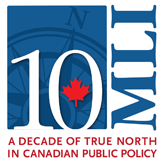
Donald Trump’s recent Truth Social post about Ukraine contains multiple disinformation narratives that align with Kremlin propaganda.
The Claims
- Zelenskyy “talked” the U.S. into spending $350 billion on a “war that couldn’t be won and never had to start.”
- The U.S. has spent $200 billion more than Europe, and Europe’s contributions are “guaranteed” while the U.S. will “get nothing back.”
- Zelenskyy admitted that “half the money sent to him is missing.”
- Zelenskyy refuses to hold elections and is a “dictator without elections” who is unpopular in Ukraine.
- Trump is the only one capable of negotiating peace with Russia, while Biden and Europe have failed.
- Zelenskyy wants to keep the “gravy train” of U.S. support going.
- Millions of Ukrainians have “unnecessarily died,” and Ukraine is “shattered” because of Zelenskyy’s failures.
The Facts
-
Ukraine did not start the war, Russia did.
- Russia launched its full-scale invasion of Ukraine on February 24, 2022, violating Ukraine’s sovereignty and international law. The claim that the war “never had to start” ignores the fact that Putin chose to invade Ukraine. Russia has targeted civilian infrastructure, kidnapped nearly 20,000 Ukrainian children and its soldiers have engaged in well documented war crimes, including the rape of Ukrainian women and children.
-
The $350 billion figure is exaggerated.
- The U.S. has committed approximately $86 billion in military, humanitarian, and economic aid to Ukraine since 2022, not $350 billion.
- The EU and its member states have actually committed more financial aid than the U.S., with a total of €144 billion ($155 billion) in pledged support. Trump’s claim that Europe’s contributions are “guaranteed” while the U.S. will “get nothing back” is misleading.
-
There is no evidence that “half the money” sent to Ukraine is missing.
- This claim appears to be a distortion of a mistranslated or fabricated narrative. Ukraine has faced corruption challenges in the past, but the Pentagon and independent watchdogs have found no evidence of widespread misuse or theft of U.S. aid.
- U.S. military aid is primarily in the form of weapons and equipment, not direct cash transfers.
-
Ukraine’s elections were postponed due to wartime law, not dictatorship.
- Ukraine is under martial law due to the Russian invasion, making elections legally and logistically impossible.
- Zelenskyy has expressed willingness to hold elections if security and funding conditions allow, but doing so in an active war zone is unrealistic.
- Ukraine remains a democracy with a free press and political opposition, unlike Russia.
-
Trump’s claim to be the only one who can negotiate peace ignores diplomatic efforts already underway.
- Biden and European leaders have consistently sought diplomatic solutions, but Putin has refused negotiations unless Ukraine surrenders its territory.
- Ukraine has put forth peace plans, but Russia has dismissed them. Trump’s assertion that he alone can negotiate peace is unfounded and echoes Kremlin narratives aimed at undermining U.S. and NATO efforts to support Ukraine.
-
Zelenskyy does not benefit from prolonging the war.
- The claim that Ukraine is continuing the war for financial gain is a well-worn Kremlin disinformation tactic meant to delegitimize Ukrainian resistance.
- Ukraine is fighting for survival, not for profit.
-
The war is not Zelenskyy’s fault, nor has he failed in leadership.
- Millions of Ukrainians have been displaced or killed due to Russian attacks, not Zelenskyy’s leadership.
- Ukraine has repelled Russia’s attempts to seize Kyiv and much of the country, thanks to Zelenskyy’s leadership and Western support.
Narrative Context
1. Aligns with Russian Disinformation Framing Zelenskyy as Corrupt
- The claim that Ukraine is stealing or misusing U.S. aid is a longstanding Kremlin disinformation trope designed to erode Western support.
- This aligns with Russian efforts to paint Ukraine as an unworthy ally and discourage further U.S. aid.
2. Undermines NATO and Western Support for Ukraine
- The argument that Europe should be paying more than the U.S. plays into Russian attempts to divide the transatlantic alliance and weaken military support.
- Trump’s suggestion that the war does not concern the U.S. because of its geographic distance ignores Ukraine’s strategic importance to global security and NATO stability.
3. Echoes Kremlin Claims That Ukraine Cannot Win
- Stating that the war is “unwinnable” is a core Russian disinformation narrative meant to weaken morale in Ukraine and the West.
- Ukraine has successfully defended against Russia’s full-scale invasion, and military experts do not consider Ukraine’s position hopeless.
4. Delegitimizes Ukraine’s Leadership and Government
- Calling Zelenskyy a dictator while ignoring Putin’s actual dictatorship mirrors Russian propaganda aimed at discrediting Ukraine’s government.
- Suggesting that Ukraine’s political system is illegitimate serves Russian objectives of destabilization and weakening support for Ukraine’s democracy.
5. Reinforces Trump’s Self-Promotion While Parroting Russian Narratives
- The claim that only Trump can negotiate peace is a common theme in his campaign rhetoric, but it also mirrors Putin’s attempts to frame Biden and NATO as warmongers while casting Trump as a potential peace broker.
- Russian state media has openly supported Trump’s narrative on Ukraine, portraying him as a candidate who would weaken U.S. support for Kyiv.
Trump’s post directly echoes multiple Kremlin disinformation narratives, from portraying Ukraine as corrupt and incompetent to claiming that NATO and the U.S. are being exploited. The post undermines U.S. support for Ukraine, delegitimizes its government, and sows divisions within NATO—goals that align closely with Russian propaganda efforts.
Trump’s framing of the war as a “gravy train” and his emphasis on negotiating with Russia without addressing Russia’s role as the aggressor align with Putin’s information warfare strategies targeting Western audiences.
This post is a textbook example of Russian-aligned disinformation, repackaged through Trump’s political messaging to weaken U.S. resolve and erode public support for Ukraine.

